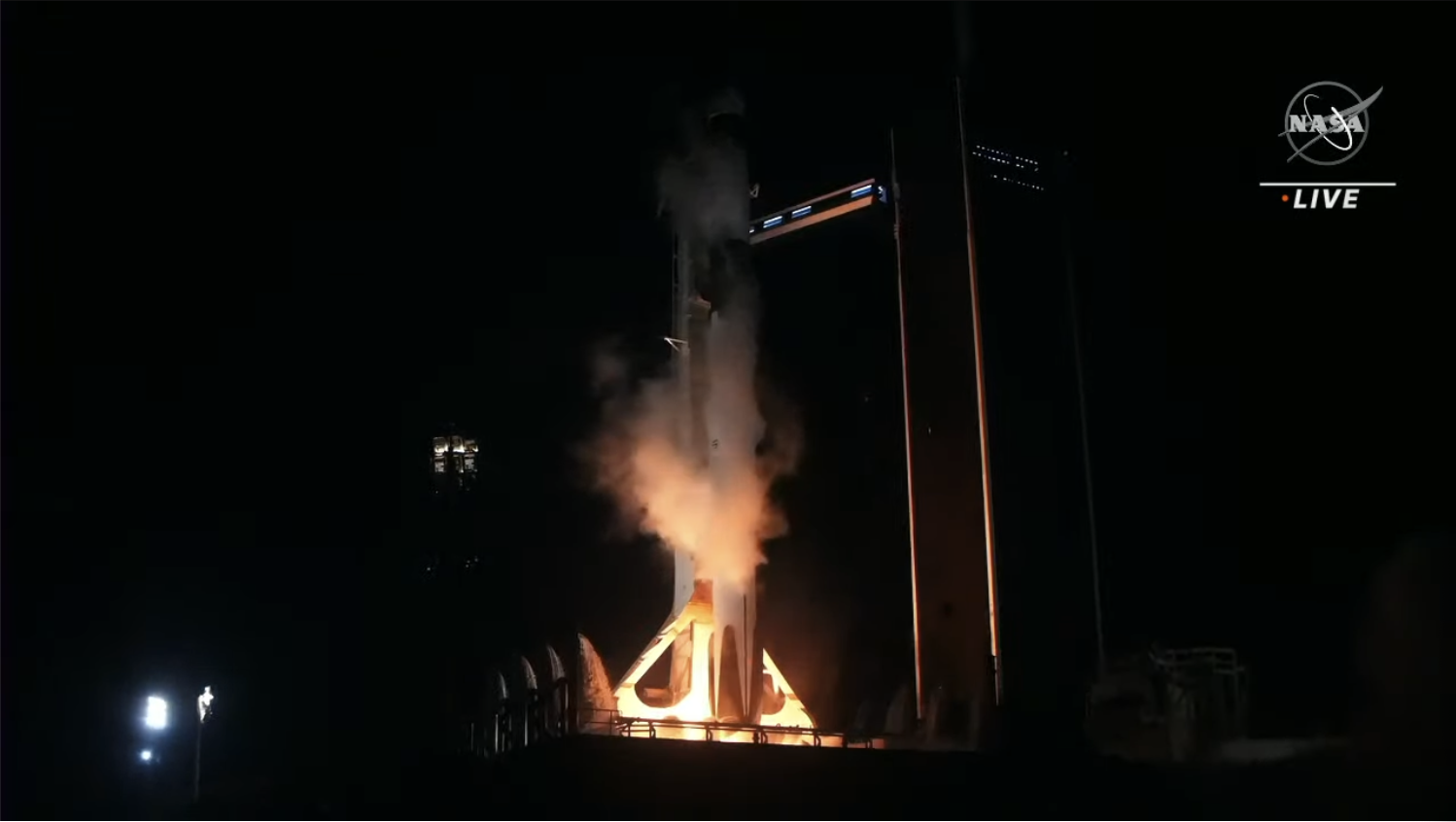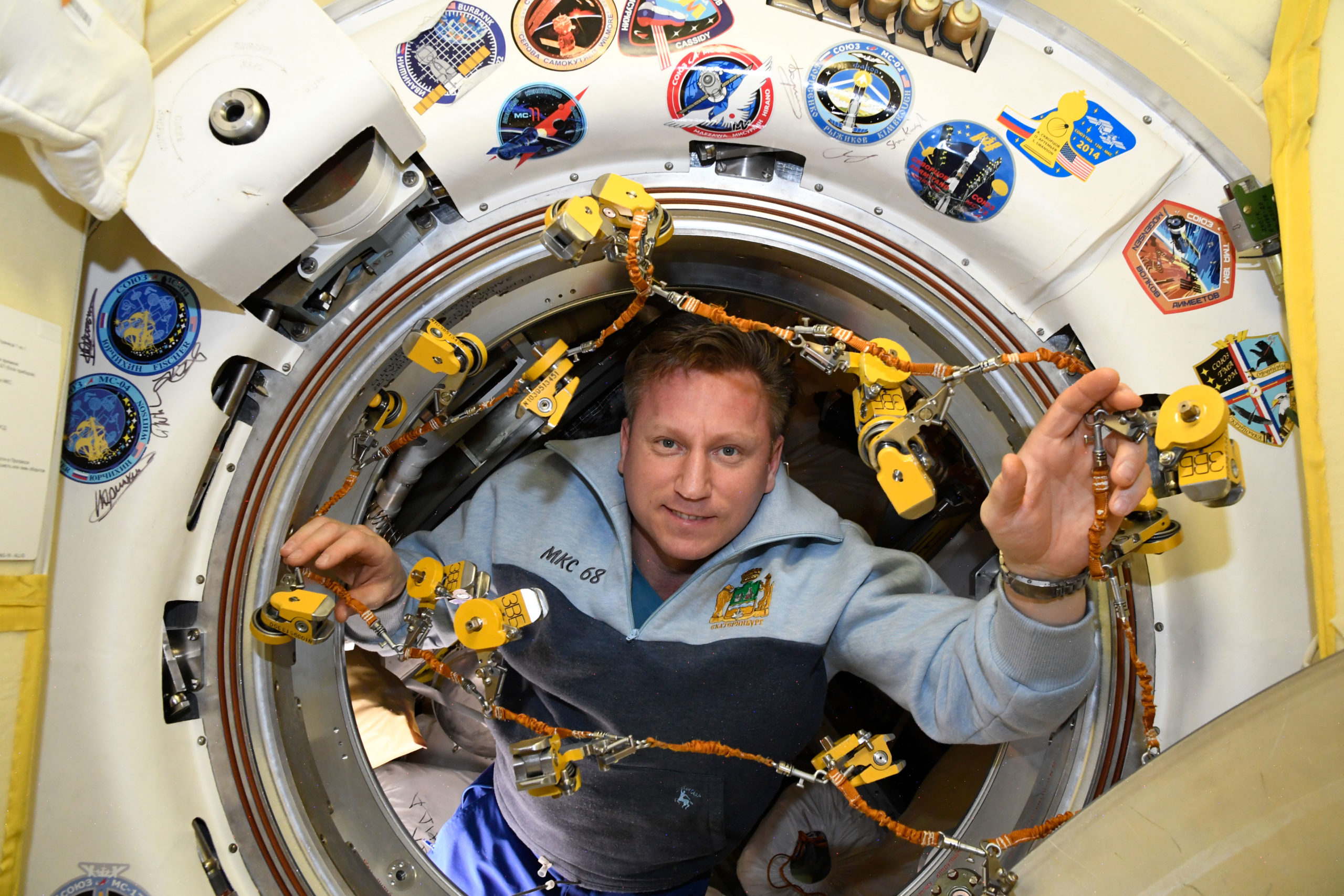
After suffering a scrubbed launch attempt just past midnight on Monday, Crew-6 is finally en-route to the International Space Station (ISS), following the rousing 12:34 a.m. EST Thursday rise of a brand-new Falcon 9 from historic Pad 39A at Florida’s Kennedy Space Center (KSC). Veteran astronaut Steve Bowen—who logged three shuttle missions and seven sessions of Extravehicular Activity (EVA) between November 2008 and March 2011, including Discovery’s swansong voyage—was accompanied aboard the four-times-flown Dragon Endeavour by fellow NASA flyer Warren “Woody” Hoburg, Russian cosmonaut Andrei Fedyayev and Sultan Al-Neyadi of the United Arab Emirates (UAE).
Powering into the night under the 1.5 million pounds (680,000 kilograms) of thrust from her nine Merlin 1D+ engines, B1078 became only the second “single-stick” Falcon 9 to enter SpaceX’s fleet thus far in 2023. The booster arrived in Florida in early February, having completed a lengthy test campaign at SpaceX’s Rocket Development Facility in McGregor, Texas, and—as is customary—was put through a brief Static Fire Test on Pad 39A last Friday.

But Crew-6’s opening launch attempt at 1:45 a.m. EST Monday came to nought, when an ominous “Hold, Hold, Hold” call echoed over the countdown net and clocks were stopped at T-2 minutes and 12 seconds. Since the launch window was “instantaneous”, any hold of any length forced an immediate scrub and SpaceX engineers set to work draining the Falcon 9’s propellants, disarming the launch abort system and returning the Crew Access Arm (CAA) alongside Dragon Endeavour’s hatch to allow Bowen and his men to disembark.

“I promised my kids to return soon and I didn’t mean this soon,” Al-Neyadi tweeted his 32,500 followers with wry humor on Monday. “Anyway, our crew is safe and our spirits are high. A launch scrub is one of those things that we are trained to do, as crew safety is always a priority.”
The cause of the last-minute scrub arose from “an unusual data signature” pertaining to confirmation of the proper “bleed-in” of Triethylaluminum-Triethylboron (TEA-TEB), an ignition fluid used on the Falcon 9’s nine Merlin 1D+ first-stage engines. “The bleed-in process ensures there is an adequate supply of this fluid at each engine to mix with liquid oxygen to start the engines,” NASA explained early Wednesday.

“During pre-launch, the TEA-TEB—which originates in a ground supply tank—flows to the rocket’s interface and back to a catch tank to remove gas from the ground plumbing,” the space agency added. “During engine start, the fluid then flows to the engines for ignition. Flow into the catch tank is one of several parameters used to determine that the fluid has been properly bled into the system.”
After a thorough data review, NASA and SpaceX engineers determined that there was a reduced flow back to the catch tank, caused by a clogged ground filter. Teams replaced the filter, purged the TEA-TEB line with nitrogen and verified that the hardware is clean and ready to support a second launch attempt at 12:34 a.m. EST Thursday.

With the hardware on Crew-6’s side, so too was Mother Nature, pledging a 95-percent chance of acceptable conditions for Thursday’s just-past-midnight launch. Only the minor chance of a rain shower appearing over Pad 39A around launch time posited a potential violation.
“A low-pressure system is moving through the Great Plains, as high pressure builds back into Florida and the ascent corridor,” noted the 45th Weather Squadron at Patrick Space Force Base in a Tuesday afternoon update. “Through the day Wednesday, this low-pressure area will move into the Ohio Valley and strengthen as the high-pressure ridge slides east of the ascent corridor.

“By launch time early Thursday, the ridge will extend from South Florida to Bermuda, creating moderate winds in the staging area, due to the pressure gradient between the ridge and a low-pressure area,” the 45th continued. “Launch weather remains favorable, with only a very slight chance of a shower developing over the pad at launch time.”
Late Wednesday, Bowen, Hoburg, Fedyayev and Al-Neyadi departed KSC’s Neil Armstrong Operations & Checkout Building to ride a pair of Tesla Model X cars out to the pad. Over the next couple hours, they ascended the gantry, took their seats inside Dragon Endeavour and headed smartly into communications, pressure and leak checks.

Liftoff of SpaceX’s first mission of March came at 12:34 a.m. EST and B1078 roared uphill, her exhaust piercing the darkness for the first 2.5 minutes of ascent. She then separated from the stack and—in a sight seen so often, yet which retains an inherent ability to impress—pirouetted home to alight on the deck of the Autonomous Spaceport Drone Ship (ASDS), “Just Read the Instructions”, situated offshore in the Atlantic Ocean.
With B1078 gone, the single Merlin 1D+ Vacuum engine of the Falcon 9’s second stage ignited for a six-minute “burn” to lift Dragon Endeavour into her preliminary orbit. Twelve minutes after launch, Dragon Endeavour separated from the second stage and entered free flight, opening her nose cone to deploy her docking hardware shortly afterwards.

Bowen’s crew will now jump into a 24.5-hour rendezvous profile, lasting 16 orbits of the Home Planet, which should lead to an autonomous docking of Dragon Endeavour at the space-facing (or “zenith”) port of the station’s Harmony node at 1:17 a.m. EST Friday. This will give Crew-6 the second-longest launch-to-docking profile of any ISS-bound Crew Dragon flight so far.
After the completion of pressurization and leak checks, hatches into the orbital complex will swing open and the newcomers will be welcomed aboard by Expedition 68 Commander Sergei Prokopyev, his Russian crewmates Dmitri Petelin and Anna Kikina, Japan’s Koichi Wakata and U.S. astronauts Frank Rubio, Nicole Mann and Josh Cassada. These seven astronauts and cosmonauts have all been on the station since last fall.

Hatch opening is targeted for 3:27 a.m. EST Friday, with a welcoming ceremony expected a few minutes thereafter. This will begin a six-month increment for Crew-6, spanning the final weeks of Expedition 68 and the bulk of Expedition 69, during which they will welcome a pair of SpaceX Cargo Dragons in March in June and a single Northrop Grumman Corp. Cygnus resupply ship next month.
Additionally, they will be aboard for the arrival of two piloted vehicles. The long-awaited Crew Flight Test (CFT) of Boeing’s CST-100 Starliner—crewed by Commander Barry “Butch” Wilmore and Pilot Suni Williams—is slated for mid-to-late April.

And Ax-2, the second all-private ISS mission for Houston, Texas-based AxiomSpace, Inc., is provisionally targeted for the mid-May timeframe. The latter will be commanded by America’s most flight-experienced astronaut Peggy Whitson, joined aboard SpaceX’s Dragon Resilience by entrepreneur John Shoffner and a pair of crew members from the Kingdom of Saudi Arabia (KSA), biomedical scientist Rayyanah Barnawi and Royal Saudi Air Force captain and fighter pilot Ali Al-Qarni.
After tomorrow’s docking, Bowen, Hoburg, Fedyayev and Al-Neyadi will enjoy a short handover with Mann, Cassada, Wakata and Kikina, who have been aboard the ISS since last October. The outgoing crew are scheduled to depart the ISS aboard their Dragon Endurance ship no sooner than Wednesday 8 or Thursday 9 March, for a parachute-assisted splashdown off the Florida Coast, wrapping up over 150 days in orbit and a new cumulative record for a single Crew Dragon of more than 320 days across the first two missions of her spacefaring career.

With the departure of Mann and her crew, Expedition 68 will continue under Prokopyev’s command until late March, when the Soyuz MS-22 spacecraft undocks from the station in an uncrewed capacity and returns to Earth. At the instant of undocking, Expedition 69 will officially begin, with Prokopyev expected to retain command until he, Petelin and Rubio return home aboard Soyuz MS-23 in September.
Early plans outlined last fall called for Bowen to command the first half of Expedition 69, with Russia’s Oleg Kononenko—originally slated to lead Soyuz MS-23 to orbit in March, alongside fellow cosmonaut Nikolai Chub and NASA astronaut Loral O’Hara—commanding the second half. But when a coolant leak sprang last December aboard Soyuz MS-22, Roscosmos elected to launch Soyuz MS-23 to the ISS in late February in an uncrewed capacity, to serve as a “rescue” vehicle, and extend the stay of Prokopyev, Petelin and Rubio from six months to nearly a full year.

As such, Prokopyev looks set to secure a personal record for the longest continuous tenure as an ISS Commander, having taken the helm of Expedition 68 last October from Italy’s Samantha Cristoforetti. The current record-holder, Mike Lopez-Alegria, spent 202 days at the helm of the station during his almost-seven-month-long Expedition 14 increment between September 2006 and April 2007.
With Bowen, Hoburg, Fedyayev and Al-Neyadi expected to stay aboard the ISS until late August, they will nominally remain as members of Expedition 69 through the end of their own increment. A “direct handover” in August will begin with the arrival of Crew-7, which includes U.S. astronaut Jasmin Moghbeli, Japan’s Satoshi Furukawa, Denmark’s Andreas Mogensen—flying on behalf of the European Space Agency (ESA)—and an as-yet-unnamed four crew member, widely tipped to be Russian cosmonaut Konstantin Borisov.

And when Prokopyev, Petelin and Rubio return home aboard Soyuz MS-23 in the September timeframe, the next ISS command passes to ESA, with Mogensen becoming the first Dane to command the orbital complex. He will lead Expedition 70 through his own crew’s return to Earth in the spring of 2024.
Meanwhile, Kononenko—whose crew of Chub and O’Hara is now targeting a September 2023 launch aboard Soyuz MS-24—looks set to command the final phase of Expedition 70, early next spring, ahead of his own return home in March 2024. “That is the plan,” NASA told AmericaSpace, “but all of this command rotation activity is highly dependent on when these flights actually fly and are all subject to change.”






17 Comments
17 Pings & Trackbacks
Pingback:SpaceX Launches From Vandenberg, Pushes Starlink Count North of 4,000 - AmericaSpace
Pingback:SpaceX Launches From Vandenberg, Pushes Starlink Count North of 4,000 - Space News
Pingback:Crew-5 Splashes Down, Wraps Up Five-Month ISS Mission - AmericaSpace
Pingback:Three Falcon 9 Missions Lie Ahead, as CRS-27 Readies for Launch Tonight - AmericaSpace
Pingback:SpaceX Flies Eighth Mission of March, Looks to Ninth Launch Tomorrow - AmericaSpace
Pingback:NASA, Boeing Target NET 21 July for Starliner Crew Flight Test (CFT) Launch - AmericaSpace
Pingback:SpaceX Flies Hosted Mission for Intelsat & NASA, Heads for Year’s 25th Mission - AmericaSpace
Pingback:NASA, Axiom, SpaceX Discuss Upcoming Ax-2 Space Station Mission - AmericaSpace
Pingback:SpaceX Launches 22 Starlinks, Kicks Off Busy June Manifest - AmericaSpace
Pingback:SpaceX, ULA Target Thursday Pre-Dawn Launches, Six Minutes Apart - AmericaSpace
Pingback:50th Falcon Mission of 2023 Flies, Falcon Heavy Realigns for Friday Night Launch - AmericaSpace
Pingback:SpaceX Targets Year’s 50th Falcon 9 Launch Tonight - AmericaSpace
Pingback:SpaceX Targets 12 months’s fiftieth Falcon 9 Launch Tonight - technewscombomber.in
Pingback:As Falcon 9 Passes Year’s 50th Flight, SpaceX Heads for 50th Vandenberg Launch - AmericaSpace
Pingback:Crew-7 FRR Concludes, Dragon Endurance Ready for Friday Pre-Dawn Launch - AmericaSpace
Pingback:Crew-6 Reflects, as Crew-7 Prepares - AmericaSpace
Pingback:Crew-7 Launches, Four Nations En-Route to Space Station - AmericaSpace